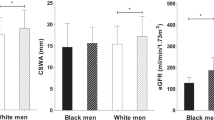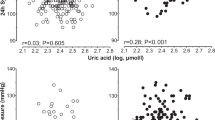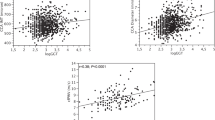Abstract
Oxidative stress has been implicated in the development of hypertension, arterial stiffness and atherosclerosis. Optimal functioning of the enzymatic antioxidant system is central to prevent increased oxidative stress and its consequences. We aimed to investigate the relationships of ambulatory blood pressure and carotid intima-media thickness with enzyme activities of the glutathione cycle in 396 young, black and white South Africans of the African-PREDICT study. Ambulatory blood pressure and carotid intima-media thickness were measured and glutathione peroxidase and glutathione reductase activities were analyzed. Black participants had higher reactive oxygen species (men: p = 0.019; women: borderline p = 0.064) and total glutathione (both p < 0.001), but lower glutathione peroxidase activity and total antioxidant status (all p < 0.001). In black men, ambulatory pulse pressure was negatively associated with glutathione peroxidase activity (R2 = 0.19; β = −0.25; p = 0.06). Black and white women displayed positive associations of ambulatory systolic blood pressure (black: R2 = 0.25; β = 0.21; p = 0.048; white: R2 = 0.44; β = 0.18; p = 0.016) with glutathione reductase activity, whereas white men displayed a positive association of ambulatory pulse pressure with glutathione reductase activity (R2 = 0.25; β = 0.29; p = 0.01). The lower glutathione peroxidase activity and total antioxidant status, the higher reactive oxygen species, as well as the negative association between ambulatory pulse pressure and glutathione peroxidase activity in the black men suggest that oxidative stress may be associated with early vascular changes in this group. In the other three groups, the positive associations of blood pressure with glutathione reductase activity suggest a possible role for adequate glutathione reductase activity in preventing or delaying the development of hypertension.
This is a preview of subscription content, access via your institution
Access options
Subscribe to this journal
Receive 12 digital issues and online access to articles
$119.00 per year
only $9.92 per issue
Buy this article
- Purchase on Springer Link
- Instant access to full article PDF
Prices may be subject to local taxes which are calculated during checkout


Similar content being viewed by others
References
Rodrigo R, Prat H, Passalacqua W, Araya J, Guichard C, Bachler JP. Relationship between oxidative stress and essential hypertension. Hypertens Res. 2007;30:1159.
Tsiropoulou S, Dulak-Lis M, Montezano AC, Touyz RM. Biomarkers of oxidative stress in human hypertension. In: Andreadis E (eds). Hypertension and cardiovascular disease. Springer, Cham; 2016. p 151-70.
Montezano AC, Dulak-Lis M, Tsiropoulou S, Harvey A, Briones AM, Touyz RM. Oxidative stress and human hypertension: vascular mechanisms, biomarkers, and novel therapies. Can J Cardiol. 2015;31:631–41.
Ogah OS, Rayner BL. Recent advances in hypertension in sub-Saharan Africa. Heart. 2013;99:1390–7.
Campbell NR, Bovet P, Schutte AE, Lemogoum D, Nkwescheu AS. High blood pressure in sub‐Saharan Africa: why prevention, detection, and control are urgent and important. J Clin Hypertens. 2015;17:663–7.
Addo J, Smeeth L, Leon DA. Hypertension in sub-saharan Africa: a systematic review. Hypertension. 2007;50:1012–8.
Sliwa K, Wilkinson D, Hansen C, Ntyintyane L, Tibazarwa K, Becker A, et al. Spectrum of heart disease and risk factors in a black urban population in South Africa (the Heart of Soweto Study): a cohort study. Lancet. 2008;371:915–22.
Schutte AE, Schutte R, Huisman HW, van Rooyen JM, Fourie CM, Malan NT, et al. Are behavioural risk factors to be blamed for the conversion from optimal blood pressure to hypertensive status in Black South Africans? A 5-year prospective study. Int J Epidemiol. 2012;41:1114–23.
Maritz M, Fourie CM, Van Rooyen JM, Moss SJ, Schutte AE. Large artery stiffness is associated with gamma-glutamyltransferase in young, healthy adults: the African-PREDICT study. J Am Soc Hypertens. 2016;10:772–81.e1.
Schutte AE, Huisman HW, Schutte R, Van Rooyen JM, Malan L, Malan NT, et al. Arterial stiffness profiles: investigating various sections of the arterial tree of African and Caucasian people. Clin Exp Hypertens. 2011;33:511–7.
Mokhaneli MC, Fourie CMT, Botha S, Mels CMC. The association of oxidative stress with arterial compliance and vascular resistance in a bi-ethnic population: the SABPA study. Free Radic Res. 2016;50:920–8.
Higashi Y, Kihara Y, Noma K. Endothelial dysfunction and hypertension in aging. Hypertens Res. 2012;35:1039–47.
Taddei S, Virdis A, Ghiadoni L, Salvetti G, Bernini G, Magagna A, et al. Age-related reduction of NO availability and oxidative stress in humans. Hypertension. 2001;38:274–9.
Wang JC, Bennett M. Aging and atherosclerosis: mechanisms, functional consequences, and potential therapeutics for cellular senescence. Circ Res. 2012;111:245–59.
Kruger R, Schutte R, Huisman H, Van Rooyen J, Malan N, Fourie C, et al. Associations between reactive oxygen species, blood pressure and arterial stiffness in black South Africans: the SABPA study. J Hum Hypertens. 2012;26:91–97.
van Zyl C, Huisman HW, Mels CM. Antioxidant enzyme activity is associated with blood pressure and carotid intima media thickness in black men and women: the SABPA study. Atherosclerosis. 2016;248:91–96.
Schutte R, Schutte AE, Huisman HW, van Rooyen JM, Malan NT, Peter S, et al. Blood glutathione and subclinical atherosclerosis in African men: the SABPA Study. Am J Hypertens. 2009;22:1154–9.
Marfell-Jones MJ, Stewart A, de Ridder J. International standards for anthropometric assessment. 2012. Wellington, New Zealand: International Society for the Advancement of Kinanthropometry.
Touboul PJ, Hennerici MG, Meairs S, Adams H, Amarenco P, Bornstein N, et al. Mannheim carotid intima-media thickness and plaque consensus (2004-2006-2011). An update on behalf of the advisory board of the 3rd, 4th and 5th watching the risk symposia, at the 13th, 15th and 20th European Stroke Conferences, Mannheim, Germany, 2004, Brussels, Belgium, 2006, and Hamburg, Germany, 2011. Cerebrovasc Dis. 2012;34:290–6.
Abiaka C, Al-Awadi F, Olusi S. Effect of prolonged storage on the activities of superoxide dismutase, glutathione reductase, and glutathione peroxidase. Clin Chem. 2000;46:560–76.
Hayashi I, Morishita Y, Imai K, Nakamura M, Nakachi K, Hayashi T. High-throughput spectrophotometric assay of reactive oxygen species in serum. Mutat Res/Genet Toxicol Environ Mutagen. 2007;631:55–61.
Faul F, Erdfelder E, Lang A, Buchner A. G* Power 3: a flexible statistical power analysis program for the social, behavioral, and biomedical sciences. Behav Res Methods. 2007;39:175–91.
Ungvari Z, Kaley G, de Cabo R, Sonntag WE, Csiszar A. Mechanisms of vascular aging: new perspectives. J Gerontol A Biol Sci Med Sci. 2010;65:1028–41.
Mitchell GF, Parise H, Benjamin EJ, Larson MG, Keyes MJ, Vita JA, et al. Changes in arterial stiffness and wave reflection with advancing age in healthy men and women: the Framingham Heart Study. Hypertension. 2004;43:1239–45.
Weber T, Auer J, O’Rourke MF, Kvas E, Lassnig E, Berent R, et al. Arterial stiffness, wave reflections, and the risk of coronary artery disease. Circulation. 2004;109:184–9.
Betteridge DJ. What is oxidative stress? Metab Clin Exp. 2000;49:3–8.
Patel RS, Al Mheid I, Morris AA, Ahmed Y, Kavtaradze N, Ali S, et al. Oxidative stress is associated with impaired arterial elasticity. Atherosclerosis. 2011;218:90–95.
Devine PJ, Carlson DW, Taylor AJ. Clinical value of carotid intima-media thickness testing. J Nucl Cardiol. 2006;13:710–8.
Weber MA, Schiffrin EL, White WB, Mann S, Lindholm LH, Kenerson JG, et al. Clinical practice guidelines for the management of hypertension in the community. J Clin Hypertens. 2014;16:14–26.
Kotsis V, Stabouli S, Karafillis I, Nilsson P. Early vascular aging and the role of central blood pressure. J Hypertens. 2011;29:1847–53.
Handy DE, Lubos E, Yang Y, Galbraith JD, Kelly N, Zhang YY, et al. Glutathione peroxidase-1 regulates mitochondrial function to modulate redox-dependent cellular responses. J Biol Chem. 2009;284:11913–21.
Blankenberg S, Rupprecht HJ, Bickel C, Torzewski M, Hafner G, Tiret L, et al. Glutathione peroxidase 1 activity and cardiovascular events in patients with coronary artery disease. N Engl J Med. 2003;349:1605–13.
Torzewski M, Ochsenhirt V, Kleschyov AL, Oelze M, Daiber A, Li H, et al. Deficiency of glutathione peroxidase-1 accelerates the progression of atherosclerosis in apolipoprotein E-deficient mice. Arterioscler Thromb Vasc Biol. 2007;27:850–7.
Chrissobolis S, Didion SP, Kinzenbaw DA, Schrader LI, Dayal S, Lentz SR, et al. Glutathione peroxidase-1 plays a major role in protecting against angiotensin II-induced vascular dysfunction. Hypertension. 2008;51:872–7.
Hamanishi T, Furuta H, Kato H, Doi A, Tamai M, Shimomura H, et al. Functional variants in the glutathione peroxidase-1 (GPx-1) gene are associated with increased intima-media thickness of carotid arteries and risk of macrovascular diseases in japanese type 2 diabetic patients. Diabetes. 2004;53:2455–60.
Acknowledgements
The African-PREDICT study would not have been possible without the participants who voluntarily participated in this study. We thank all the students, support staff and researchers of the Hypertension Research and Training Clinic at the North-West University for their dedication and support throughout this study. The research funded in this article is part of an ongoing research project financially supported by the South African Medical Research Council (SAMRC) with funds from National Treasury under its Economic Competitiveness and Support Package; the South African Research Chairs Initiative (SARChI) of the Department of Science and Technology and National Research Foundation of South Africa; the Strategic Health Innovation Partnerships (SHIP) Unit of the SAMRC with funds received from the South African National Department of Health, GlaxoSmithKline R&D, the UK Medical Research Council and with funds from the UK Government’s Newton Fund; as well as corporate social investment grants from Pfizer (South Africa), Boehringer-Ingelheim (South Africa), Novartis (South Africa), the Medi Clinic Hospital Group (South Africa) and in kind contributions of Roche Diagnostics (SA). Any opinion, findings, and conclusions or recommendations expressed in this material are those of the authors, and therefore, the NRF do not accept any liability in regard.
Author information
Authors and Affiliations
Corresponding author
Ethics declarations
Conflict of interest
The authors declare that they have no conflict of interest.
Electronic supplementary material
Rights and permissions
About this article
Cite this article
Myburgh, C., Huisman, H.W. & Mels, C.M.C. The relation of blood pressure and carotid intima-media thickness with the glutathione cycle in a young bi-ethnic population: the African-PREDICT study. J Hum Hypertens 32, 268–277 (2018). https://doi.org/10.1038/s41371-018-0044-3
Received:
Revised:
Accepted:
Published:
Issue Date:
DOI: https://doi.org/10.1038/s41371-018-0044-3



